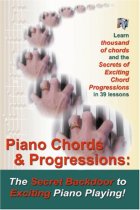Major Triads – 3 Note Chords
Major Triads – The Root, 3rd & 5th Of a Major Scale
| Good morning, this is Duane and today I would like to talk about triads. You know about chords of course, there can be 5 note chords and 4 note chords and complex chords, all kinds of course and of course you know that. Today I’d just like to take up major triads. A triad, like trio or tricycle is a 3 note chord and they of course are the basis of all complex chords, so we need to really master triads first before we have hope of dealing with thirteenths and flatted ninths and all that complex kind of thing as well as voicing.
|
| A lot of the sounds you get has to do with the way you position the chord on the keyboard. For example, here’s a sixth chord and here’s a ninth chord but if I voice it like this instead that adds a little different sound than if you play the whole chord. In other words I was leaving something out. I was voicing a chorus right then. It depends on how you voice a chord but it all starts with a mastery of triads. Let’s just think through triads. There are major triads, minor triads, augmented triads and diminished triads.
|
| Let’s look at major triads today. A major triad is a three note chord made out of the root, third and fifth of whatever the major scale is for that key. For example, if I am in the key of C that’s a major scale right there and it follows a formula that goes like this: whole step, whole step, half step, whole step, whole step, whole step, half step. In other words: whole, whole, half, whole, whole, whole, half, okay? Now that’s easy to see when you’re in the key of C but if say you’re in the key of B, what’s a whole step above B? It’s not C, that’s a half step so you go up to C sharp so the second note on the B scale is C sharp. The third note is D sharp, the fourth note is F a half step up. Then a whole step which is F sharp, G sharp, A sharp and B so we say the key of B has five sharps. I know somebody will ask me, “Why can’t that be D flat?” Well it could be but that would be really confusing because then you’d have sharps and flats in the same key and it’s easy to keep it straight if you call them all sharps and all flats.
|
| Besides that if you went from B to D flat you would be leaving out C in that scale; you’d have no C. You’d go from B to D, right? That just wouldn’t make sense. Say you’re in the key of B based on that scale, if you take the root third and fifth that’s the major triad for that particular key based on the root third and fifth of that scale. Okay? If you’re in the key of B flat you have to figure out what the scale is in the key of B flat using that same formula: whole step, whole step, half step, whole step, whole step, whole step, whole step, half step. If I take the root third and fifth of B flat that’s the triad based on B flat. That’s the B flat major triad.
|
| The A major triad would look like that. The A flat major triad would look like that. The G major triad would look like that with the third and fifth. The G flat major triad would look like that. The F major triad based on that scale would look like that. The E major triad based on this scale would look like that, the third and fifth. The E flat major scale goes like so, if I take the third and fifth that’s the E flat major chord. The D major chord would be like that, the root, third, and the fifth. D flat major chord would be like that: root, third and fifth of the D flat scale. Okay?
|
| There’s 12 possible notes you can build a chord on: 1,2,3,4,5,6,7,8,9,10,11,12 so there’s 12 possible triads, right? 12 possible major triads. C, C sharp or D flat, D, and so on and so if you’re not already familiar with those get familiar with those because those are the basis for all other complex chords.
|
| Tomorrow we’ll take up minor triads and then we’ll take up diminished triads and then we’ll take up augmented triads and then we’ll take up diminished triads and then we’ll take up augmented triads and then we’ll get on to the more complex chords. That’s it until tomorrow so if you enjoy these kind of things come on over to playpiano.com and sign up for our free series of newsletters and videos and you’ll get simple stuff like that plus you’ll get a lot of complex tips as well. So come on over and sign up. See you then, bye bye for now.
|
Click on this link to watch this video on YouTube: https://www.youtube.com/watch?v=KQBfqjBk8jU
***For lots more good stuff on piano playing come on over to my website at https://www.playpiano.com and sign up for our free piano tips – “Exciting Piano Chords & Sizzling Chord Progressions!”
Here’s a great little book on chords and chord progressions on Amazon: http://www.amazon.com/Piano-Chords-Chord-Progressions-Exciting-ebook/dp/B0076OUGDE/ref=sr_1_1?s=books&ie=UTF8&qid=1404158669&sr=1-1&keywords=piano+chords+duane+shinn
ÂÂÂÂÂÂÂÂÂÂÂÂÂÂÂÂÂÂÂÂÂÂÂÂÂÂÂÂÂÂÂÂÂÂ____________________________________________________________________________________




